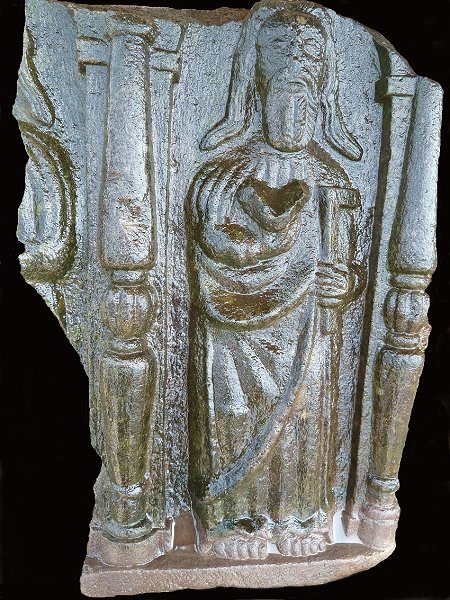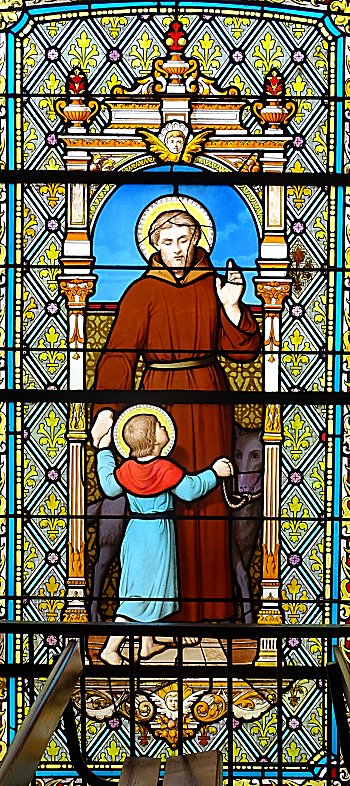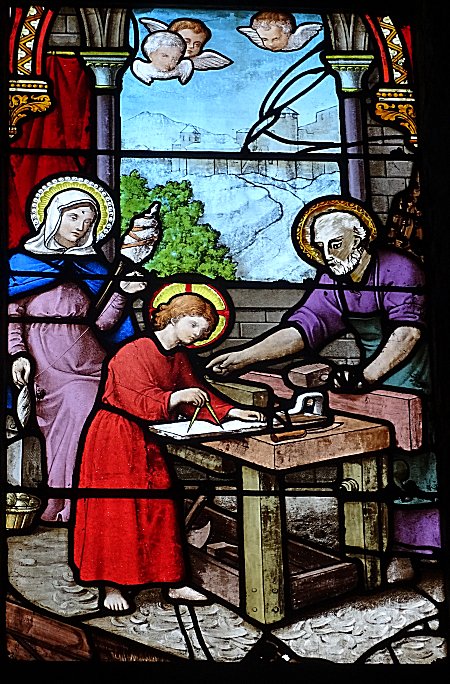Notre-Dame de Liesse Church
( Municipality of Saint-Renan)

Parking GPS : 48°25'55.8 N 4°37'30.8 W

Access :
Park preferably in the car park on Place St-Herbot and walk to the church.
Formely, at the emplacement of this church, there used to be a small chapel called Notre-Dame ( Our Lady ). It is necessary to go back to 1728 to see, added to this appellation, the precision "of Liesse" ( of jubilation ). A probable reference to the basilica of the same name, in Champagne, where the kings as well as many popular pilgrimages venerated the Black Virgin.
The chapel saw its bell tower collapse in 1768. It was then decided to rebuild and enlarge it. The new building, built entirely of local granite, was completed in 1772. Twenty years later, during the Revolution, the chapel was erected as a parish church, as being larger and more beautiful than the old Saint-Ronan church at the lower city. Notre-Dame de Liesse was then enlarged in 1869, 1891, then restored in 1905.


The bell tower bears little resemblance to those of the surrounding parishes. Its square tower is extended, above the gallery and the chamber of bells, by a dome supporting a high lantern, while two polygonal turrets with stairs, one of which houses the clock, are adjacent.

One will notice the original orientation of this church whose bell tower and porch are on the east and the chancel on the west so that its access is by the street rather than by the cemetery.
The interior is very large. The barrel vault rests on pillars that determine six spans and two aisles. The 1869 extension added a chancel with seven neo-Romanesque arches, an ambulatory and three radiant chapels.

At right as you enter, a marble baptistery awaits newborns.

The ten round pillars of the arcades of the chancel form a semicircle. The first two are even quadruples. All support carved neo-Romanesque capitals.


Sculptures from the former St. Ronan's Church still adorn the altar's basement. They represent five of the twelve apostles. A restoration was carried out following a break at the top right, of which one guesses the trace.

From the left are the apostles Peter, Andrew, John, Bartholomew and Simon. A sixth apostle, Thomas, once completed this ensemble. Recovered after the break, it is now part of the collections of the Musée du Ponant.

The work of 1891 consisted in building an immense gallery above the entrance.

The stained-glass windows
Large stained-glass windows illuminate the nave and aisles. They are true masterpieces, realized during the restoration of 1905 by the workshop of master glassmakers Haussaire and Payan1, in Paris.
It is an original exposition of the Breton saints who are venerated in the Iroise country.
These characters appear generally in episcopal dress. Were they really bishops? Historians prefer substitute the term "influence area" of a monk, hermit or abbot of a small religious Community for the term bishopric. Most of these monks would have lived at the beginning of the Merovingian era and the evangelization of Brittany is assigned to them.
It is necessary to go up in the gallery to discover for example on the left Saint Rivoaré, the patron saint of Lanrivoaré's parish, in company of his blind nephew Saint Hervé who keeps on a leash the wolf serving him as guide. The Saint Hervé hermitage is located in Lanrivoaré and can be visited freely. (
The hermitage of Saint Hervé ).
On the opposite wall Saint Yves is the patron saint of lawyers, but also the defender of the poor. He is venerated in several places of Iroise country, notably in Trébabu. He holds in his hands a code and a scroll attesting to his function as a judge. (
Trébabu).

Saint Rivoaré and his nephew Saint Hervé |

Saint Yves |
Around the nave, one discovers successively on the left, under the gallery:
St. Guinel ( or Gwénaël ), without a beard because he became bishop very young, is the patron saint of Plougonvelin. He would have born in 454 in Quimper and died in Vannes after having lived several years in Ireland.
Further on, Saint Tugdual2 ( colloquially called Saint Pabu ), carries a gospel. Of Welsh origin, he would have landed on the peninsula of Kermorvan at Le Conquet. Patron saint of Trebabu, he was according to legend a fellow student of Saint Ildut and would have died in 564 after having been appointed bishop of Tréguier by King Childebert 1st and even having been pope for two years. But we have no historical evidence of that.

Saint Guinel |

Saint Tugdual |
Saint Peter, carrying the key to paradise and a scroll, is the patron saint of the churches of Ploumoguer and Lamber. (
Lamber).

Saint Peter
Saint Sané, bearing the Gospel, is the patron saint of Plouzané. Legend has it that he would have came from Ireland and reached the beach of Perzell in Plougonvelin. Companion of Saint Ronan, he would have founded the church of Locmaria-Plouzané and died in 485.
Saint Germain l'Auxerrois appears in the building because he owned an old chapel in the church. We know that he received from the Pope the mission to fight the heresy of pelagianism3. We see him here holding a dragon on a leash, which is never seen in his various representations. If the dragon obviously symbolizes paganism and heresies, we can think that this stained-glass attributes to the founder of the Auxerre's abbey the feat of another Saint Germain contemporary of the first. Indeed, Saint Germain à la Rouelle, which was baptized by the Auxerrois, is supposed to have evangelized part of Brittany and Normandy and unlike Saint Germain d'Auxerre, is still represented holding on a leash the dragon he would have captured in the Cotentin. Saint Germain l'Auxerrois died in 448.

Saint Sané |

Saint Germain |
The following four stained-glass windows are dedicated to the Blessed Virgin.
Saint Anne, grandmother of Christ, is the patron saint of all Brittany. With her husband Joachim, she teaches Mary the Holy Scriptures. Down, Ste-Anne's Basilica in Auray.
L'Assomption: Our Lady, the patron saint of this church like that of Locmaria-Plouzané, is carried to paradise by angels.
The Good Death : Mary confirms the extreme anointing administered by a priest to a dying person.
The Blessed Virgin brings souls from purgatory into heaven.
Then around the chancel, in honor's place :
Saint Corentin : he is the patron saint of the whole diocese of Quimper. According to legend he would have been the first bishop of it, towards the end of the Vth century. We see him here receiving this appointment from King Gradlon. The latter would have been amazed by a miracle performed by the saint : after a meal of fish, they would have miraculously come back to life.

Saint Corentin
One of the characters, on the left, recalls the miracle by brandishing a fish.
Paray-le-Monial:
The Sacred Heart appears to Sainte Marguerite-Marie Alacoque.
The Sacred Heart : Devotion.
Saint Pol-Aurélien: Coming from Wales with 70 other monks, he would have reached the land around the year 480 in Lampaul on the island of Ouessant. Then he would have lived at Lampaul-Plouarzel, Lamber, and at Lampaul-Ploudalmézeau of which he is now the patron saint of the church. (
the church of Lampaul-Ploudalmézeau ).
Then he would have gained St-Pol-de-Léon, center of the diocese which was entrusted to him by Childebert 1er in 530. He died on the island of Batz. We see him here received by the king. We notice that the kings are kneeling in the presence of the saints.

Saint Pol Aurélien
The following two very realistic stained-glass windows are dedicated to the Holy Family.

Jesus, the apprentice carpenter |

The death of Saint Joseph |
Then come :
Saint Ronan .
This saint of Irish origin crossed the English Channel in the 6th century in a stone trough and reached the Leonard shore. Gone back up the Aber Ildut river, he would have founded his hermitage at the place called Toul an Aon, not far from a spring, where today is the town hall of St-Renan. Later, he would have settled in Cornwall's country, at Locronan, probably on the emplacement of the present church which houses his tomb. Of course he is the patron saint of the St-Renan's parish, but also of Molène.
(
The church of Molène )
.
Saint Ronan appears in bishop's dress on this stained-glass window, casting out the demon from the body of a sick person. In Locronan, Saint Ronan is said to have resurrected his enemy's daughter, the woman Keben, who we see knocked down, at the far left.

Saint Ronan |

Saint Arzel |
Saint Arzel ( or Ourzal ): at the beginning of the VIth century, also would have crossed the Channel and founded a hermitage on the south bank of the Aber Ildut river, in Plouarzel. Then pursuing a wandering life in order to evangelize the population, he would have criss-crossed Brittany and several localities today bear his name. Legend has it that he defeated a dragon with only his stole and holy water as his weapons. This patron saint of the church of Plouarzel also shares with Saint Pol-Aurélien the patronage of the church of Ploudalmézeau. He is represented here as a bishop (
the church of Plouarzel: ).
Further on, here is Saint Matthieu. He was one of Christ's twelve apostles. With his pen, he writes a gospel. A legend4 claims that his relics were brought back from Egypt to the IVth century and deposited some time in the abbey of St-Mathieu headland of which depended the priory of St-Renan (
St. Matthew's Point Abbey ).
Today they are kept in the cathedral of Salerno, Italy.

Saint Matthew |

Holy Cross |
The Holy Cross is the patron saint of the Conquet. Among them are from left to right Dom Michel Le Noblez and Father Julien Maunoir, Breton missionaries of the XVIIth century. The tomb of Dom Michel is inside the church of Le Conquet (
Le Conquet's church ).
His residence at Le Conquet is today a chapel (
Dom Michel Chapel ).
Saint Gouesnou would have been a companion of Saint Pol-Aurélien to whom he would have succeeded as bishop of Leon. It is said that he founded a monastery in Gouesnou and died in 675.

Saint Gouesnou |

Saint Sebastian |
Saint Sébastien would have lived in IIIth century. Originally from Narbonne and centurion in the Roman army, he was reportedly denounced for his Christian faith and died a martyr under the arrows. Its representation on a stained-glass window recalls that an old chapel was dedicated to him in the city.
The statues
In 1969, in application of the Second Vatican Council, many of the church's ornaments were removed, including statues that were placed in the Brest Religious Museum. But we kept some of them as the very beautiful statue of Saint Roch, which dates from the XVth century.

The saint, wounded, is represented here with his pilgrim stick
and accompanied by his dog, Roquet,
bringing him like every day a bread that he stole.

Saint Ronan

Behind the altar, Notre-Dame des Victoires, acquired in 1804 |

Notre Dame de Liesse, patron saint of the church. Wooden statue of the XVIth century. |

Surrounded by 7 cherubs painted on a panel,
it once welcomed the faithful under the entrance porch.
The bells
Of course, for safety reasons, the public does not have access to the bell tower stairs. They lead to the gallery of the chamber of the two bells, through which one reaches the skylight which houses a third, smaller one.

The originality of this church, the quality of its stained-glass windows and its beautiful statue of Saint Roch are particularly noteworthy. As for the choice of saints that it presents on its stained-glass windows, and which gives pride of place to certain Breton saints, we would have liked to see Saint Haude, Saint Samson, Saint-Ildut, Saint Ergat, Saint Budoc or Saint Egarec who sponsor other religious buildings in the Iroise country. But it must be understood that the initial choice was limited to the canton of St-Renan and that it has been completed or modified by that of the donors, among whom some priests or some families had ties out of the Iroise country. The gallery of saints is therefore neither exhaustive nor exclusively Breton, which may also reflect the desire to show a certain universality of faith.
***
Léon Payan designed and made the stained-glass windows of a large number of churches and chapels in Brittany. For more information on this artist and his work, see the very documented website dedicated to him. ( site Léon Payan )
-2- Read on the internet the page entitled "Saint Tugdual" written by Jean-Pierre Clochon, historian of Le Conquet ( Saint Tugdual ).
He relates the arrival of Saint Tugdual in the peninsula of Kermorvan and explains the origin of his nickname Saint Pabu.
3- Pelagianism is a Christian doctrine spread at the end of the IVth century in the Roman Empire by the monk Pelagius, born in Great Britain. In opposition to Saint Augustine, Pelagius denied original sin and divine pardon. He considered that man had his free will and gained paradise or hell directly according to the acts accomplished in his life. Baptism losing its meaning, the Council of Carthage in 418 and Pope Zozime have condemned this doctrine as heresy.
4- The story of this legend appears in "La translation des reliques de Saint Mathieu", booklet published by "Les Amis de Saint Mathieu" and available at the "Musée de la Pointe St-Mathieu", in Plougonvelin. A critical analysis of this legend by the historian Joseph Loth can be found on the internet.
(
The analysis )
.
Thanks to Mr. Jos Saliou and the association "Musée du Ponant" which he co-chairs, for their help and loan of documents.




